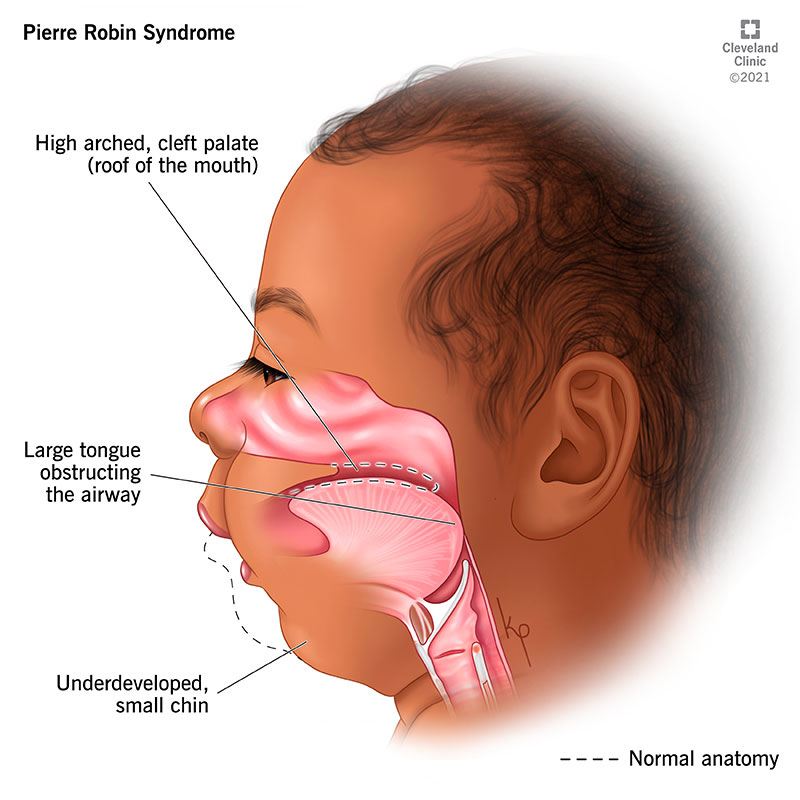Pierre Robin syndrome (PRS) is an uncommon birth defect. Babies with this disorder may have underdeveloped jaws and difficulty breathing. Their tongues may fall to the back of their throats. PRS may be mild or severe. In some cases, babies don’t need treatment. Other times, they may need surgery and ongoing medical care.
Advertisement
Cleveland Clinic is a non-profit academic medical center. Advertising on our site helps support our mission. We do not endorse non-Cleveland Clinic products or services. Policy

Pierre Robin syndrome (PRS), or Pierre Robin sequence, is a rare birth defect that happens during fetal development. It’s a group of conditions that affect your baby’s jaw and mouth so it may be hard for them to breathe, nurse or feed from a bottle. Most babies receive a diagnosis right after they’re born.
Advertisement
Cleveland Clinic is a non-profit academic medical center. Advertising on our site helps support our mission. We do not endorse non-Cleveland Clinic products or services. Policy
Your baby’s healthcare providers will recommend treatment and things that you can do to help your baby. They may use other names like Pierre Robin malformation when talking about this syndrome.
Pierre Robin syndrome is a rare condition. Approximately 1 in every 8,500 people have PRS.
Pierre Robin syndrome causes physical differences that you and your baby’s healthcare team may notice right after your baby is born, including:
These physical differences from PRS may cause symptoms like:
Experts don’t know the exact cause of PRS. Certain genetic mutations that happen during fetal development may change the sequence or order in how a fetus’s facial structure forms. The sequence begins with how the fetus’s jaw develops:
Advertisement
This sequence of events is why healthcare providers call the condition Pierre Robin sequence.
Yes, they can. For example, Pierre Robin syndrome may be a complication of Stickler syndrome, which is a genetic condition that affects connective tissues that support and give structure to other organs in your body, primarily in the face, ears, eyes and joints.
If your baby has a severe form of PRS, issues that block their airway may lead to life-threatening complications, including:
It’s probably scary to think about all the things that could happen. If your baby has a severe form of PRS, it may help to know your baby’s healthcare team is keeping a close watch for complications. They’ll move quickly to diagnose and treat any complications your baby may experience.
Often, pediatricians diagnose Pierre Robin syndrome during routine newborn health checks done right after babies are born. But your baby may have a mild form of the syndrome. In that case, your baby’s provider may notice symptoms during the first checkup that happens three to five days after you bring your baby home, or in the next few early checkups.
For example, they may notice your baby isn’t gaining weight or has stridor. In that case, they may do a physical examination to find out why your baby is having issues. If they suspect your baby has Pierre Robin syndrome, their provider will:
That depends on your baby’s symptoms. In some cases, babies’ symptoms improve as they get older. For example, your baby’s lower jaw may grow. When that happens, their tongue is less likely to fall back into their airway, so they don’t have breathing issues. If your baby has a mild form of Pierre Robin syndrome, they may not need treatment.
If they have severe PRS, treatment may include:
Advertisement
If your baby has a severe form of the condition, they may need surgery and other treatment early on to help them breathe, drink and eat. They may need ongoing medical care and support. In general, treatment eases babies’ symptoms so they don’t have long-term issues. With treatment, most babies with Pierre Robin syndrome live as long as babies who don’t have the condition.
There’s no cure for Pierre Robin syndrome. It’s a congenital condition that’s present at birth. It happens during fetal development. But there are treatments to manage its symptoms.
If your baby has a mild form of Pierre Robin syndrome, you’ll need to follow their pediatrician’s advice about sleeping positions and ways to feed your baby.
Babies with moderate or severe symptoms may need ongoing support and medical care, including surgery.
Your baby’s healthcare team knows it can be scary and overwhelming when your child has serious medical issues. They’ll be there for your baby and for you. They’ll:
Advertisement
Your baby will have regular checkups depending on their symptoms. But you should contact their provider if your baby’s symptoms seem to be getting worse.
Pierre Robin syndrome is rare, and you may not know much about the condition. Learning as much as you can about it will help you feel confident when you make decisions about your baby’s medical care. Here are some questions you may want to ask:
You may learn your baby has Pierre Robin syndrome right after they’re born. Or you may notice your baby has trouble nursing, and tests show they have the syndrome. Either way, you may feel stunned and scared to learn your little one has a serious medical condition. The diagnosis is life-changing for your baby, you and your family. Your baby’s healthcare team understands how Pierre Robin syndrome can upend daily life. They’ll be there for you as you work through what your baby’s diagnosis means now and for their future.
Advertisement
If you have conditions affecting your ears, nose and throat, you want experts you can trust. Cleveland Clinic’s otolaryngology specialists can help.

Last reviewed on 05/29/2024.
Learn more about the Health Library and our editorial process.